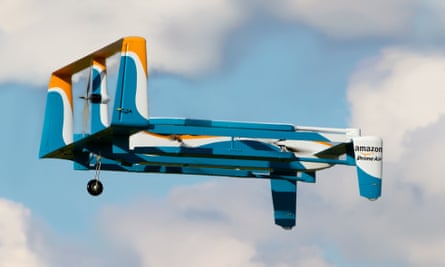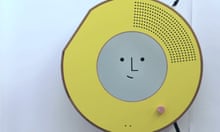In the battle for the 21st century workplace, computers are winning. And the odds of us puny humans making a comeback are not very good.
The Guardian’s product and service reviews are independent and are in no way influenced by any advertiser or commercial initiative. We will earn a commission from the retailer if you buy something through an affiliate link. Learn more.
A January 2017 report from the McKinsey Global Institute estimated that roughly half of today’s work activities could be automated by 2055, give or take 20 years. (McKinsey helpfully offers a search portal to find out how likely you’ll be given the boot by a bot.)
Bottom line is robots want our jobs. And no one is going to build a wall around them or tariff them out of existence.
In a way this is nothing new. Technology has been replacing human labor since the invention of the wheel. Typically, though, machines have stepped in to perform relatively low-skill, low-wage, highly repetitive work. The least digitizable jobs have belonged to recreational therapists, members of the medical profession, social workers, teachers, and managers. The reason: computers are not yet as good as humans at things like personal interaction and off-the-cuff decision making.
But that’s changing.
Thanks to advances in artificial intelligence, natural language processing, and inexpensive computing power, jobs that once weren’t considered good candidates for automation suddenly are.
For example, a decade ago researchers thought the complexity of navigating an automobile around obstacles and through traffic was beyond the reach of silicon. Now virtually every auto maker (as well as companies like Apple) is working on a driverless car.
The number and types of jobs that computers can do has expanded enormously in just a few years, ranging from the predictable to the absurd.

- Middle managers: last month, the world’s largest hedge fund announced it was developing algorithms to automate management decisions, including the hiring and firing of employees. Bridgewater Associates’s ambitious PriOS project is based on the philosophy of its billionaire founder Ray Dalio; the company hopes to roll it out within five years.
- Lawyers: next time you get stung by a meter maid you may be able to hire a robo-lawyer. DoNotPay has helped more than 160,000 people fight tickets in London, New York and Seattle, and will soon be expanding to San Francisco, Los Angeles, Denver and Chicago. Fill out a questionnaire; if the legal bot decides you have a legit case, it fires off a letter contesting the citation. The company claims a success rate of 60%.
- Journalists: AI bots created by companies such as Narrative Science and Automated Insights are already cranking out business and sports stories for clients like Forbes and the Associated Press. In a June 2015 interview with the Guardian, Narrative Science co-founder Kris Hammond predicted 90% of journalism will be computerized by 2030, and that some hardworking j-bot will nab a Pulitzer sooner than that.
- Therapists: human-like “social robots” are already being used to help teach children on the autism spectrum appropriate social behavior. Therapeutic robot pets provide companionship for seniors with dementia. The US military is using a computer-generated virtual therapist to screen soldiers in Afghanistan for PTSD.
- Teachers: software such as McGraw-Hill Connect and Aplia allow college professors to manage the coursework for hundreds of students at a time. Massive open online courses (Moocs) extend their reach to thousands more. And actual physical robots are being used to teach English to students in Japan and Korea.
- Actors: Peter Cushing, who died in 1994, reprised his role as Grand Moff Tarkin in 2016’s Rogue One: A Star Wars Story, thanks to some digital wizardry by Industrial Light & Magic. But he’s hardly the first human actor to have returned from the grave. Paul Walker, Audrey Hepburn, Sir Laurence Olivier, Bruce Lee and Marlon Brando have all been digitally resurrected for use in films and commercials.
- Cookbook authors: in January 2015, IBM Watson – the Jeopardy-winning cognitive computing platform – published a cookbook. The tome’s 65 recipes include instructions on how to whip up creole shrimp-lamb dumplings and brew hoof-and-honey ale.
- Delivery people: Aloft Hotels is experimenting with a robot butler (called “Botlr”) to deliver towels or toiletries to your room. (It won’t accept tips, but does encourage tweets.) Looking like a Roomba on steroids, Starship Technologies’ delivery robot can shuttle food and packages to destinations within a nearby radius. DoorDash and Postmates have announced partnerships with Starship Technologies Starship Technologies. And in December, Amazon delivered its first package to a customer using an unmanned aerial vehicle (aka drone). Amazon Prime Air promises to deliver packages weighing under five pounds in 30 minutes or less.

- Drivers: Uber and Lyft have made no secret of their plans to replace thousands of amateur cabbies with robots, though early tests have run into a few regulatory and safety snags. Fleet vehicles like taxis and city buses are likely to be the first to be automated, possibly by the early 2020s.
Is there any hope?
The tasks least likely to be replaced by a computer, according to a widely cited 2013 Oxford study on job digitization, are those requiring the highest degrees of social and creative intelligence. But even there the digitized writing is on the LCD wall.
For years, computers have been creating art, music and literature – just usually not very good art, music and literature. Robot poetry and computer-generated music have become genres unto themselves, but so far they’ve failed to have much impact on the already dismal employment prospects for human poets and musicians. Last February, the first algorithmically authored musical, Beyond the Fence, debuted in London’s West End – though to less than stellar reviews.
Still, there are glimmers of a future where algorithms and artists compete head to head. The winner of the 2016 RobotArt competition, National Taiwan University’s TAIDA, creates pointillist-style compositions that would not look out of place hanging next to a Seurat.
Last April, a computer-generated novel titled, appropriately enough, The Day a Computer Writes a Novel, was in the running for Japan’s Hoshi Shinichi Literary Award. The judges were unaware the book was produced via AI.
Kulitta, music composition software written by Yale computer science lecturer Donya Quick, has fooled “musical sophisticates” into thinking its original phrases were composed by Johann Sebastian Bach, according to a report in Yale News.
Are all of these people capable of acquiring new skills? And even if they are, do they want to do it?
But for the time being – or at least until algorithms learn how to suffer for their art – humans will continue to have the upper hand when it comes to creativity.
“Highly creative jobs are probably pretty safe for a while,” says Tom Davenport, co-author of Only Humans Need Apply: Winners and Losers in the Age of Smart Machines. “There have been a few attempts to have computers write screenplays and TV scripts, and they have been uniformly horrible thus far.”
There are other hopeful signs.
Instead of being replaced wholesale, most people in high-skill positions will likely find themselves working alongside their inanimate colleagues, not unlike the way we use computers instead of typewriters and calculators. McKinsey estimates that 60% of today’s occupations have at least some portion that can be automated.
This is already happening in fields such as medicine, law and banking. When not writing cookbooks or kicking ass at Jeopardy, for example, IBM Watson is helping doctors diagnose medical conditions and analyze MRIs. Electronic discovery platforms such as Symantec’s eDiscovery and Kroll Ontrack help attorneys sift through thousands of documents in a few hours. And AI-driven services such as FutureAdvisor or Wealthfront help consumers make investment decisions, freeing up human financial advisers to work on more high-net-worth accounts.
Artisanal manicurist
Davenport says there are five paths for surviving in a workplace dominated by robots. You can move up in the organizational chain to monitor the computer’s work or make high-level decisions about what to computerize. You can focus on parts of your job computers aren’t good at, or find a new career where computers are less likely to dominate. Finally, he says, you can choose to work on creating the technology that will automate the 21st century.
Michael Jones, assistant professor of economics at the University of Cincinnati, believes the problem of displaced workers can be overcome with education and training – though what positions workers should be trained to fill is not entirely clear. No one knows what new jobs will look like in 10 or 20 years, just as no one anticipated the position of drone repair technician in the 1990s.
“Automation can not only create advantages for society as a whole but also for individual workers, if they can retool their skills and use technology to complement their job, not replace it,” Jones says. “But are all of these people capable of acquiring new skills? And even if they are, do they want to do it?”
Jones adds that traditional vocations like plumbers, electricians, and carpenters are likely to be less affected by digital disruption. And while easily automated jobs will be increasingly rare, they probably won’t go away entirely, says JP Gownder, vice-president and principal analyst for Forrester.
“I believe for the most part people value the human touch, but it may become a bit of a luxury good,” he says. “Imagine a world 15 or 20 years from now where most people get their manicures from robots. Rich people might still want to get one from a real person.”
And if you happen to be one of the unlucky millions who lose their job to an algorithm? A robot recruiter such as Entelo or Gild might be able to help you find a new one.










